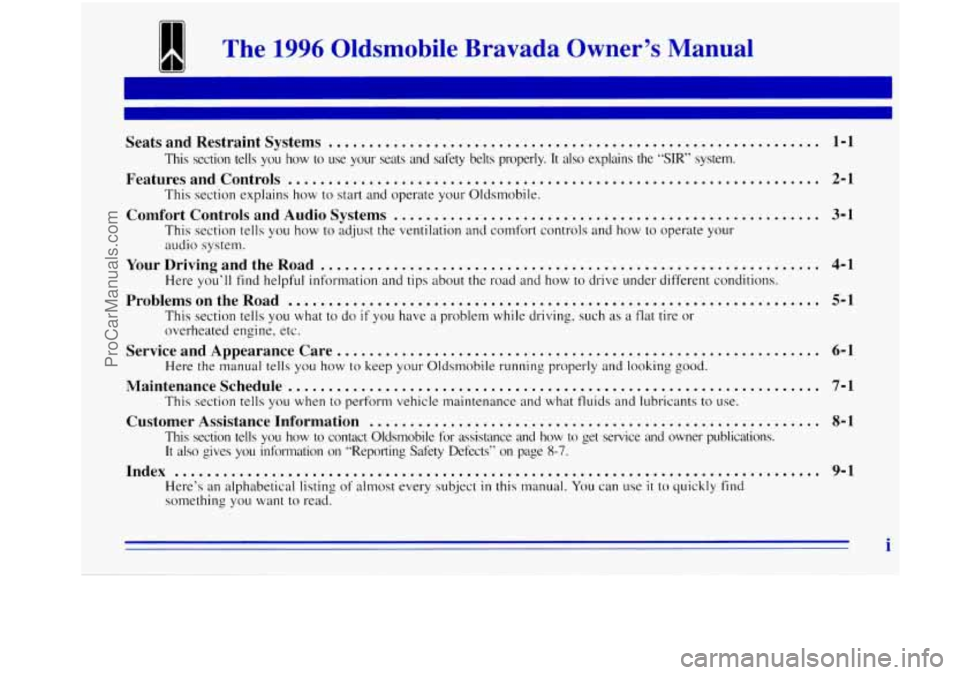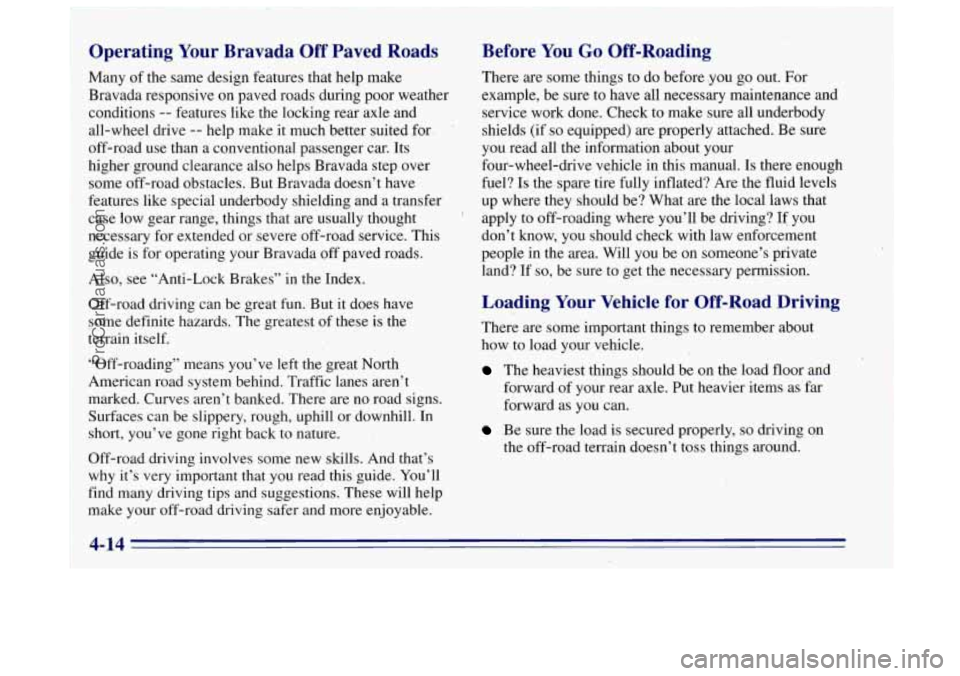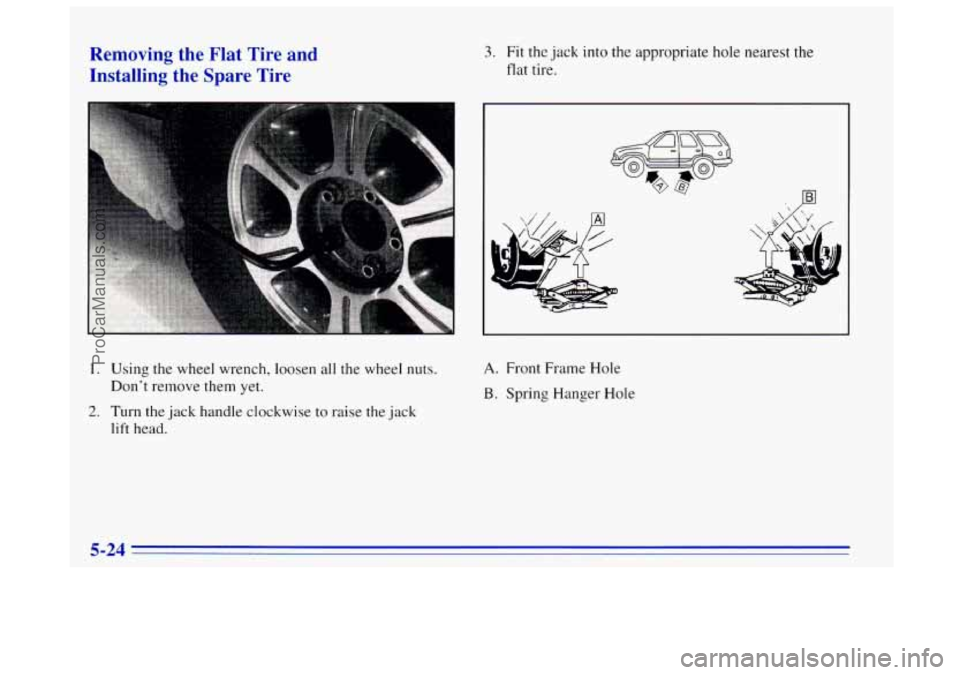flat tire OLDSMOBILE BRAVADA 1996 Owners Manual
[x] Cancel search | Manufacturer: OLDSMOBILE, Model Year: 1996, Model line: BRAVADA, Model: OLDSMOBILE BRAVADA 1996Pages: 340, PDF Size: 17.49 MB
Page 3 of 340

The 1996 Oldsrnobile Bravada Owner’s Manual
Seats and Restraint Systems ............................................................. 1-1
Features and Controls .................................................................. 2-1
Comfort Controls and Audio Systems ..................................................... 3-1
This section tells you how to use your seats and safety belts\
properly. It also explains the “SIR” system.
This section explains how to start and operate your Oldsmobile.
This section tells you how to adjust the ventilation and comfort controls and how to operate your
audio system.
Here you’ll find helpful information and tips about
the road and how to drive under different conditions.
This section tells you what
to do if you have a problem while driving, such as a flat tire or
overheated engine, etc.
Here the manual
tells you how to keep your Oldsmobile running properly and looking good.
This section tells
you when to perform vehicle maintenance and what fluids and lubricants to use.
This section tells you how
to contact Oldsmobile for assistance and how to get service and owner publications.
It
also gives you information on “Reporting Safety Defects” on pag\
e 8-7.
YourDrivingandtheRoad .............................................................. 4-1
ProblemsontheRoad .................................................................. 5-1
ServiceandAppearanceCare ............................................................ 6-1
Maintenanceschedule .................................................................. 7-1
Customer Assistance Information ........................................................ 8-1
Index ........................................................................\
........ 9-1
Here’s an alphabetical listing of almost every subject in this manual. You can use it to quickly find
something you want to read.
i
ProCarManuals.com
Page 142 of 340

Operating Your Bravada Off Paved Roads
Many of the s’ame design features that help make
Bravada responsive on paved roads during poor weather conditions
-- features like the locking rear axle and
all-wheel drive
-.- help make it much better suited for.
off-road use than a conventional passenger car. Its
higher.ground clearance also helps Bravada step over
some off-road obstacles. But Bravada doesn’t have
features like special underbody shielding and a transfer
case low gear range, things that are usually thought
necessary for extended or severe off-road service. This
guide is for operating your Bravada off paved roads.
Also, see “Anti-Lock Brakes” in the Index.
Off-road driving can be great fun. But it does have
I r some definite hazards. The greatest of these is the
’ terrain itself.
t
“Off-roading” means you’ve left the great North
marked. Curves aren’t banked. There are no road signs.
Surfaces can be slippery, rough, uphill or downhill. In
Off-road driving involves some new skills. And that’s
why it’s very important that you read this guide. You’ll
find many driving tips and suggestions. These will help
make your off-road driving safer and more enjoyable.
merican road system behind. Traffic lanes aren’t
hort, you’ve gone right back
to nature.
Before You Go Off-Roading
There are some things to do before ,you go out. For
example, be sure to have all necessary maintenance and
service work done. Check to make sure all underbody
shields (if
so equipped) are properly attached. Be sure
you read all the information about your
four-wheel-drive vehicle in this manual.
Is there enough
fuel? Is the spare tire fully inflated? Are the fluid levels
up where they should be? What are the local laws that
apply to off-roading where you’ll be driving?
If you
don’t
know, you should check with law enforcement
people in the area. Will you be on someone’s private
land? If
so, be sure to get the necessary permission.
Loading Your Vehicle for Off-Road Driving
There are some important things to remember about
how to load your vehicle.
The heaviest things should be on the load floor and
forward of your rear axle. Put heavier items as far
forward as you can.
Be sure the load is secured properly, so driving on
the off-road terrain doesn’t toss things around.
,
4-14
ProCarManuals.com
Page 162 of 340

The exit speed is usually posted.
Reduce your speed according
to your speedometer, not
to your sense of motion. After driving for any distance
at higher speeds,
you may tend to think you are going
slower than you actually are.
Before Leaving on a Long Trip
Make sure you’re ready. Try to be well rested. If you
must start when you’re not fresh
-- such as after a day’s
work
-- don’t plan to make too many miles that first part
of the journey. Wear comfortable clothing and shoes you
can easily drive
in.
Is your vehicle ready for a long trip? If you keep it
serviced and maintained, it’s ready to go. If it needs
service, have
it done before starting out. Of course,
you’ll find experienced and able service experts in
Oldsmobile retailers all across North America. They’ll
be ready and willing to help
if you need it.
Here are some things you can check before a trip:
0
0
0
0
0
0
0
Windshield Washer Fluid: Is the reservoir full? Are
all windows clean inside and outside?
Wiper Blades: Are they in good shape?
Fuel, Engine Oil, Other Fluids: Have you checked
all levels?
Lamps: Are they all working? Are the lenses clean?
Tires: They are vitally important to a safe,
trouble-free trip.
Is the tread good enough for
long-distance driving? Are
the tires all inflated to the
recommended pressure?
Weather Forecasts: What’s the weather outlook
along your route? Should you delay your trip
a short
time
to avoid a major storm system?
Maps: Do you have up-to-date maps?
ProCarManuals.com
Page 163 of 340

Highway Hypnosis
Is there actually such a condition as “highway hypnosis”?
Or is it just plain falling asleep at the wheel? Call it
highway hypnosis, lack
of awareness, or whatever.
There is something about an easy stretch
of road with
the same scenery, along with the hum
of the tires on the
road,
the drone of the engine, and the rush of the wind
against the vehicle that can make you sleepy. Don’t
let it
happen to you! If it does, your vehicle can leave the
road in less than a second, and you could crash and
be injured.
What can
you do about highway hypnosis? First, be
aware that
it can happen.
Then here are some tips:
e
e
e Make sure your vehicle is well ventilated, with a
comfortably cool interior.
Keep your eyes moving. Scan the road ahead
and
to the sides. Check your mirrors and your
instruments frequently.
If you get sleepy, pull off the road
into a rest, service
or parking area and take a nap, get some exercise, or
both. For safety, treat drowsiness
on the highway as
an emergency.
Hill and Mountain Roads
Driving on steep hills or mountains is different from
driving
in flat or rolling terrain.
ProCarManuals.com
Page 169 of 340

Loading Your Vehicle
GVWR GAWR FRT GAWR RR A IU
II 111
1
I
< SEE OWNER’S MANUAL FOR ADDITIONAL - INFORMA TlON
The CertificatiodTire label is found on the driver’s door
edge, above the door latch. The label shows the size of
your original tires and the inflation pressures needed
to
obtain the gross weight capacity of your vehicle. This is
called the GVWR (Gross Vehicle Weight Rating). The
GVWR includes the weight of the vehicle, all occupants,
fuel, cargo and trailer tongue weight, if pulling a trailer.
The CertificatiodTire label also tells you the maximum
weights for the front and rear axles, called Gross Axle
Weight Rating (GAWR). To find out the actual loads on
your front and rear axles, you need to go to a weigh
station and weigh your vehicle. Your retailer can help
you with this. Be sure to spread out your load equally on
both sides of the centerline. Never exceed
the GVWR for your vehicle, or the Gross
Axle Weight Rating (GAWR) for either the front or
rear axle.
If you do have a heavy load, you should spread it out.
Similar appearing vehicles may have different GVWR’s
and payloads. Please note your vehicle’s
Certificatioflire label or consult your retailer for
additional details.
I A CAUTION:
Do not load your vehicle any heavier than the
GVWR, or either the maximum front or rear
GAWR. If you do, parts on your vehicle can break,
or it
can change the way your vehicle handles.
These could
cause you to lose control. Also,
overloading can shorten the life of your vehicle.
I
4-41
ProCarManuals.com
Page 174 of 340

Weight of the Trailer Tongue
The tongue load (A) of any trailer is an important
weight to measure because
it affects the total or gross
weight of your vehicle. The Gross Vehicle Weight
(GVW) includes the curb weight of the vehicle, any
cargo
you may carry in it, and the people who will be
riding
in the vehicle. And if you will tow a trailer, you
must add the tongue load to the GVW because your
vehicle will be carrying that weight, too. See “Loading
Your Vehicle”
in the Index for more information about
your vehicle’s maximum load capacity.
A 6
If you’re using a weight-carrying hitch, the trailer
tongue
(A) should weigh 10 percent of the total loaded
trailer weight
(B). If you’re using a weight-distributing
hitch, the trailer tongue
(A) should.weigh 12 percent of
the total loaded trailer weight (B).
After you’ve loaded your trailer, weigh the trailer and
then the tongue, separately, to see
if the weights are
proper.
If they aren’t, you may be able to get them right
simply by moving some items around
in the trailer.
Total Weight on Your Vehicle’s Tires
Be sure your vehicle’s tires are inflated to the limit for
cold tires.
You’ll find these numbers on the
CertiFication/Tire label on the driver’s door edge, above
the door latch or see “Tire Loading”
in the Index. Then
be sure you don’t go over the GVW limit for your
vehicle, including the weight of
the trailer tongue.
Hitches
It’s important to have the correct hitch equipment.
Crosswinds, large trucks going
by and rough roads are a
few reasons why you’ll need the right hitch. Here are
some rules to follow:
4-46
ProCarManuals.com
Page 200 of 340

If a Tire Goes Flat
It’s unusual for a tire to “blow out” while you’re driving,
especially if you maintain your tires properly.
If air goes
out
of a tire, it’s much more likely to leak out slowly.
But if
you should ever have a “blowout,” here are a few
tips about what to expect and what to do:
If
a front tire fails, the flat tire will create a drag that
pulls the vehicle toward that side. Take your foot off the
accelerator pedal and grip the steering wheel
firmly.
Steer to maintain lane position, and then gently brake to
a stop well out of the traffic lane.
A rear blowout, particularly on a curve, acts much like a
skid and may require the same correction you’d use in a
skid. In any rear blowout, remove your foot from the
accelerator pedal. Get the vehicle under control by
steering the way you want the vehicle to go. It may be
very bumpy and noisy, but you can still steer. Gently
brake to a
stop -- well off the road if possible.
If a tire goes flat, the next part shows how to use your
jacking equipment to change a
flat tire safely.
Changing a Flat Tire
If a tire goes flat, avoid further tire and wheel damage
by driving slowly to a level place. Turn on your hazard
warning flashers.
ur
Changing a tire can cause an injury. The vehicle
can slip
off the jack and roll over you or other
people. You and they could be badly injured.
Find a level place to change your tire.
To help
prevent the vehicle from moving:
1. Set the parking brake firmly.
2. Put the shift lever in PARK (P).
3. Turn off the engine.
To be even more certain the vehicle won’t move,
you can put blocks at the front and rear of the
tire farthest away from the one being changed.
That would be the tire
on the other side of the
vehicle, at the opposite end.
ProCarManuals.com
Page 201 of 340

Removing the Spare Tire and Tools
The jacking equipment you'll need is stored along the
driver's rear wall. Your vehicle is also equipped
with
work gloves and a plastic ground mat to assist in the
changing
of a flat tire.
To remove the jack
cover, pull up on
the latch
at the end
of the cover,
near the endgate.
The following steps will tell you how to use the jack and
change
a tire.
Then pull up
on the latch on the top of the cover.
Remove the wheel blocks, jack and wheel wrench.
ProCarManuals.com
Page 202 of 340

The spare tire is stowed under the vehicle.
I NOTICE:
Never remove or restow a tire frondto a stowage
position under the vehicle while the vehicle
is
supported by a jack. Always tighten the tire
fully against the underside of the vehicle when restawing.
To remove the spare, insert
the chisel end
of the wheel
wrench, on an angle, into
the hole in the rear bumper.
Be sure the chisel end of the
wheel wrench connects into
the hoist shaft. Turn the wheel wrench
counterclockwise to lower the
spare tire. Keep turning the wheel wrench
until the spare
tire can be pulled out
from under the vehicle.
When the tire has been completely lowered, tilt the
retainer at the end
of the cable and pull it through the
wheel opening. Pull the tire out from under the vehicle.
NOTICE:
To help avoid vehicle damage, do not drive the
vehicle before the cable
is restored.
Put the spare tire near the flat tire.
ProCarManuals.com
Page 204 of 340

Removing the Flat Tire and
Installing the Spare Tire
I
1. Using the wheel wrench, loosen all the wheel nuts.
Don’t remove them yet.
lift head.
2. Turn the jack handle clockwise to raise the jack
3. Fit the jack into the appropriate hole nearest the
flat tire.
A. Front Frame Hole
B. Spring Hanger Hole
ProCarManuals.com